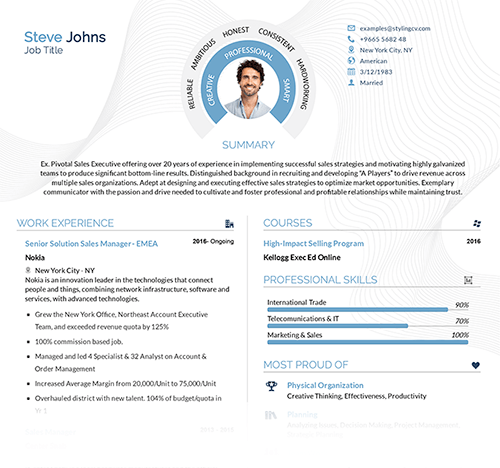
Get the right training to boost your resume and help you navigate a career switch! If you’re thinking about changing careers, it might seem daunting to put together a resume for the…
Resume Help - How can reskilling help you when changing careers?
Get your free resume nowHow can reskilling help you when changing careers?
Get the right training to boost your resume and help you navigate a career switch! If you’re thinking about changing careers, it might seem daunting to put together a resume for the new career you wish to pursue. You might feel that you haven’t got the relevant experience, knowledge or skills that could demonstrate that…
Sarah Reynolds
Content Specialist


Get the right training to boost your resume and help you navigate a career switch!
If you’re thinking about changing careers, it might seem daunting to put together a resume for the new career you wish to pursue. You might feel that you haven’t got the relevant experience, knowledge or skills that could demonstrate that you are the right fit for the job.
One solution to that is to reskill – the beauty of this solution is that it is open to all career changers regardless of your educational background or experience.
Reskilling or retraining is what many have put their faith in, from government policymakers steering their countries through the post-pandemic landscape to individuals taking stock of the changes the pandemic has wrought.
Even before the pandemic, foreseeable challenges in the economy have made reskilling and upskilling unavoidable for the large majority of us. Nine in ten British workers will need to reskill over the next decade, according to a report by the Confederation of British Industry (CBI) and McKinsey. By 2030, 26 million workers will need to upskill while 5 million will require retraining as they go through more fundamental career changes.
Upskilling = Development of skills through continuous training in order to keep up with new business and technological developments.
Reskilling = Learning of new skills or a new vocation in order to do a new role, take on new responsibilities, or go into a new career.
Results from findcourses.co.uk’s career change survey show that 83% of respondents recognise that they need to learn something new in order to change careers. However, findcourses.co.uk’s survey also shows that a significant proportion of respondents (35%) are unsure just how much training they will need.
If you are amongst the career changers who recognise you need to reskill but are unsure what or how much training to get, here are 3 simple steps to help you get started.
Step #1. Assess the resiliency of your future career path

You know that you want to change careers. You might have a fair idea of what career you want to pursue next. However, before you take the leap, it is a good idea to see how likely that occupation is going to be in demand in the future and what the current average salaries are to try to predict how these will evolve overtime.
According to the CBI and McKinsey report, technology and automation are going to be the major drivers of change in the UK job market over the next 10 years.
Research by the McKinsey Global Institute indicates that employment in the following 8 types of jobs are not expected to be displaced by automation and could even grow:
- Teachers
- Creatives e.g. artists and entertainers
- Healthcare providers
- Technology / IT professionals
- Professionals e.g. analysts, engineers, scientists and accountants
- Executives and managers
- Builders and related professions
- Service and manual jobs in unpredictable environments e.g. gardeners and home health aides
On the other hand, employment in the following occupations are likely to fall in the future because of automation:
- Office support or back-office functions e.g. finance and accounting, record clerks, and office assistants
- Some customer interaction roles e.g. food service workers, cashiers, and hotel and travel workers
- Occupations in predictable environments e.g. dishwashers, drivers, assembly line workers, food preparation workers, and agricultural and other equipment operators
The research also notes that in jobs where some tasks are automated, employment may not decline if workers can move on to perform new tasks. In addition, if the demand for that occupation increases enough to outstrip automation rates, employment in that occupation may also rise.
Tip #2. Do a skills audit and plan to bridge your skills gap

Once you’ve identified the career that you would like to reskill into, you can do a skills audit. This will help you see what skills you already have – you are likely to have more transferable skills than you realise!
By comparing your existing skill set with what is required in your chosen career, you can identify your skills gap. You can then plan to take further training to make up for the skills or qualifications you currently lack.
Here’s a heartening fact to bear in mind while doing your skills audit – people who can easily move from one role to another are not only those with skills adjacencies, that is, skills that are similar to other skills.
A LinkedIn analysis found that half of those who moved into artificial intelligence and data science professions were from unrelated occupations. This figure is even higher for engineering (67%), content (72%) and sales roles (75%).
What this shows us is that we are capable of learning entirely new things by taking training programs such as in engineering or sales training.
Given how quickly things are changing in the world of work, it is important to embrace a philosophy of lifelong learning so that you can continuously renew your capabilities and have relevant and sought-after skills.
Tip #3. Find out if you are eligible for funded training

The pandemic has caused widespread unemployment in many countries around the world. In order to combat the woes of increased unemployment, many governments are funding a variety of training programs to try and give their people the right skills to find jobs. These funding programs could be targeted at particular skill sets e.g. digital skills or at certain regions to try and encourage employment in that locality. Funding could also be offered at the national level for all types of courses.
In the UK for instance, the government has announced a wide-ranging lifetime skills guarantee that offers over 400 free courses and qualifications to eligible adults. The aim of this programme is to help people grow their careers and help the country rebuild after the pandemic.
Here’s what you should do to secure funding for your training:
- List down all the funding offered for learning including at the local, regional and national levels.
- Check whether you fulfill the eligibility criteria for any of the state funding.
- Once you’ve confirmed your eligibility, browse the funded courses that are on offer.
- Search for the training providers that provide the funded courses that you are interested in and contact them. Remember that many training providers now offer courses online, which can be a convenient option.
FAQ:
1- What do I put on my resume when changing careers?
- Create a career goal.
- Include a list of your skills.
- Prioritize your most recent professional experience.
- Describe your education (including certificates)
- Include important initiatives and achievements.
2- How do you say you’re changing careers?
For the possibility for future advancement and new challenges, I want to shift my job path. I believe my abilities and experience will be highly applicable to this new career. For instance, I noticed that your job description mentioned the capacity to oversee projects and communicate with clients, both of which were essential components of my previous position.
3- How do I transfer my skills to a new career?
A essential talents section on your CV is one strategy if you lack considerable professional work experience. This eliminates the need to spread out your transferable skills across your limited experience and enables you to arrange them in an orderly and understandable manner.
4- How do you explain why you changed career paths?
- Describe your long-term objectives. Describe how your choice to switch careers connects to your long-term professional objectives.
- Be honest and upbeat.
- Emphasize your distinct viewpoint.
- Highlight your abilities.
- Examine the business.
- Bring concrete proof.
5- What to say why you are changing jobs?
- I want a brand-new challenge.
- I’d prefer more adaptability.
- My ideals don’t match those of the organization.
- I wish my drive to work were shorter.
- is looking to move.
- I wish to work in a field in which I have more enthusiasm.
- I doubt that I receive what my market is worth.
Final thoughts
Changing careers can be immensely rewarding but it can also be scary. By continuously upgrading your skill set, you will give yourself a better chance to thrive in the future world of work. You’ll also put yourself in a great position to achieve your goals – both professional and personal – for switching careers.
About the author
Carol Pang is a Digital Content Editor for findcourses.co.uk. Prior to this, she has 12 years of experience in the corporate and financial sectors.
She believes that people are fundamental to an organisation’s success, and that effective training can create a motivated and engaged workforce.
Related articles
Tags
Build your resume in 10 minutes
Use professional field-tested resume templates that follow the exact ‘resume rules’ employers look for. Create My Resume
BUILD MY RESUME NOW


